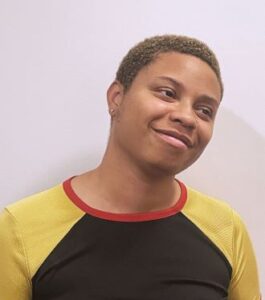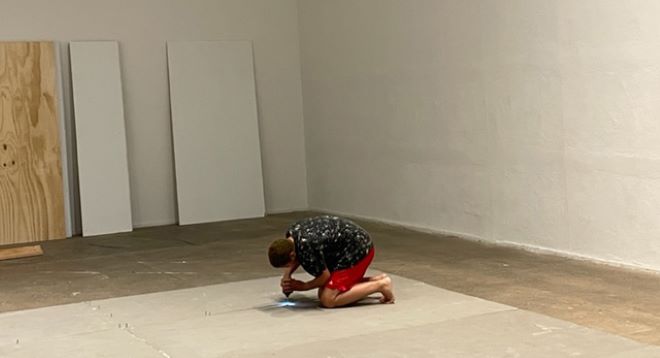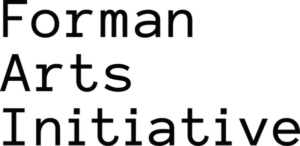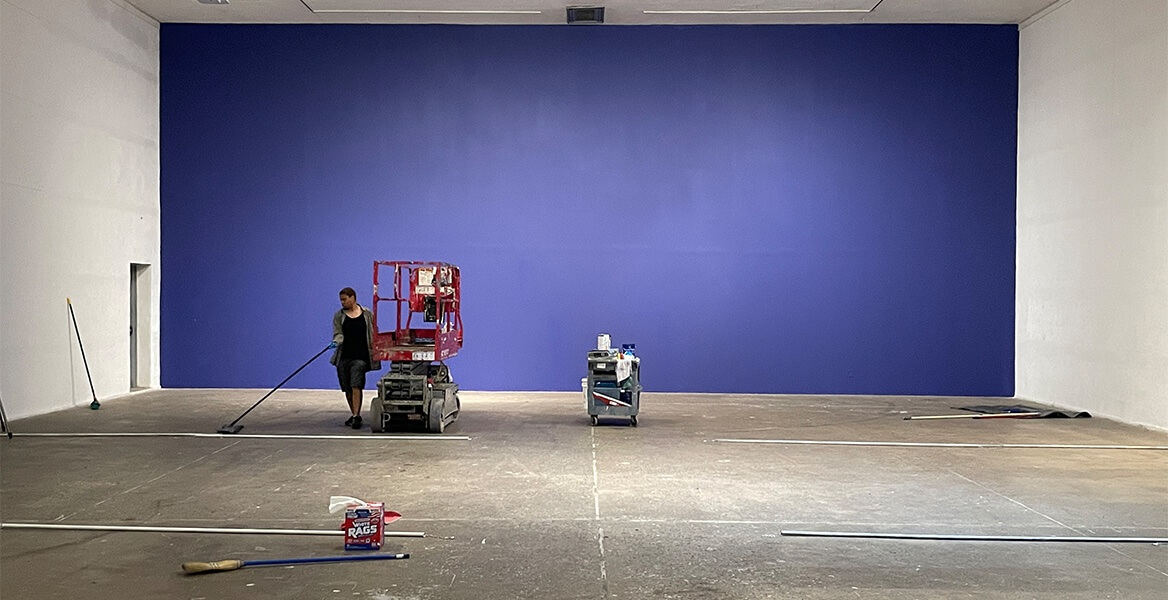Just three years after earning their BFA from Moore College of Art & Design, Logan Cryer has become the co-curator of Icebox Project Space, Philadelphia’s largest independent gallery, the co-founder of Television, an organization renting low-cost AV equipment to local curators and activists, and the founder and curator of S.N.A.I.L. Gallery, an Instagram Gallery and web archive of art writing named after Cryer’s own method of examining artwork, which is: Stop. Notice. Assess. Imagine. Leave.
Cryer doesn’t remember how they became a curatorial studies minor — they originally enrolled in Moore to study art education — but they say that a big impact was having multidisciplinary artist Li Sumpter as a professor. In Sumpter’s class, Cryer learned that curating isn’t just the act of arranging artwork on white walls; it can be anything, from hosting a party to playing a game. Sumpter’s own curatorial practice is rooted in Afrofuturism and the art of survival.
It’s truly a gift, I feel like, to give artists your attention and say, I see what you’re doing, I think it’s on purpose, I think people should take it really seriously. And I have questions about it, too.
The group of faculty and students formerly known as “Li Sumpter’s Class” became MODUS, a curating group of students, faculty, and alumni, named from the Latin term Modus Operandi or, “mode of operating.”
Independently and through MODUS, Cryer curated exhibitions of student work, printed publications, and organized pop-up shows — all while still an undergraduate. At the same time, Cryer began writing for the online arts journalism platform Artblog.
For Logan, curating has always been a more immediate act than art-making. But they see the two practices as intertwined, regardless of output.
During their attendance at Headlong Performance Institute, an artist residency program that focuses on mentorship, collaboration, and peer learning, Cryer learned to value patience over production. One of their teachers at Headlong, Shavon Norris, frames the creative process as that of “birthing baby elephants,” i.e., as the longest gestation period in existing mammals. Cryer is “slowly, and mostly privately,” working on personal artwork, they tell me.
In partnership with Forman Arts Initiative, The Citizen spoke to Cryer about their mission. A condensed and edited version of the conversation is below.
Where do you think Philly is, in terms of arts and culture?

The scale of the city is really interesting. It’s relatively a large city, but you also can generally move across it in less than an hour, right? So there’s a smallness to it. No one is that disconnected. Especially if you’re talking about people who are artists and performers, either you know everyone, or you know someone who knows them.
Then there’s the particular thing with Philly not having a lot of commercial art galleries — a lot of the artists who are living in the city don’t make a living off of selling work — that brings a different type of creativity.
There’s also an interesting, let’s call it a shift, [away from] how White the Philly professional fine arts community once was. For a long time, if you looked at artists’ collectives and galleries, a lot of them were all White; when I was coming into the city, that was the case. But now that’s shifting quite a bit, not only just in terms of who is participating in those structures, but just the way that people can organize on their own and build up their own organizations and communities.
Do you think arts coverage like your own — highlighting young artists, artists of color, and queer artists — has contributed to that shift?
I think arts journalism and art writing is so important, and it’s one of those things that’s kind of like drinking water for me, where it’s like, I don’t do it for a few days, and then I’m like, Why am I dying?
One, it exposes readers to work they may not have known about, some of which may feel really personally resonant or inspiring in a way, because they just didn’t think something like it existed. And then, for the artists that you are featuring, it offers an opportunity to reflect back on what it is that they’re doing, which can be invigorating.
In terms of what I have done, I just like writing about what I’m interested in. I’m generally interested in work that’s maybe a little more DIY, a little more experimental, and more often than not, [I find] that comes from people of color, more often than not that comes from queer people.
But I do think of arts writing as archival work. I’m always looking for that person who hasn’t had a story written about them yet; thinking, What’s significant about this particular show that I think needs to be archived?
I don’t know what that will mean for the future, but I take that very, very, seriously. And that stems from me being very locally interested, in terms of art history. I’m most interested in, like, whatever happened five years ago, where I’m standing right now. That has always been the case.
In 2017, you curated two shows at Vox Populi, an artist collective and gallery space that acknowledged their own need to be more inclusive in 2020.
I hope so. I mean, I think this is where privilege comes in, right? I was privileged enough to feel comfortable approaching Vox, to have mentors tell me, You can just ask Vox to do stuff [in their space], and they’ll probably say, Yes.
So because I had that experience, and I didn’t feel intimidated or like I didn’t belong, I was able to keep coming back and each time, bring more people into the space.
But it’s not my job to make an institution historically correct itself, or to make it more inclusive, or anything like that. It just so happens that I have access to a space, I’m just going to bring people who haven’t been there before, and who would benefit a lot from the attention, and from having their work carefully looked at and curated.
I’ve noticed when you host podcast interviews with established artists, you often ask what advice they have for young or student artists.
I think something that is really hard, especially as a young artist, especially as a student, is there’s this kind of assumption that the good things that you’re doing, you’re not aware of, or they’re not intentional; it’s a fluke.
I feel like that gets attested to young artists all the time. And so I’m really interested in saying, Let’s assume people can be thoughtful and mindful and are actually doing things for a particular reason. But also, Let’s just assume that every decision has a value to it, regardless, right?
When you’re in art school, there’s so much emphasis on critique. And there’s a space for critique. But I think there needs to be more spaces, or more ways, that we just say, Let’s act like this is like the best thing we’ve ever seen, and how can we talk about it as if everyone considered it a piece of genius?
Right. Isn’t that the benefit of the doubt given to more established artists all the time?
I mean, the way people will dissect a piece, and, Look at this, and look at that, especially around things like craft and finish.
I remember when I was in school it was like, You could not use fishline wire. If you used fishline wire in a piece, How dare you? and that was the only thing anyone could talk about [during your critique]. It creates this space where it’s like, You can’t have these types of edges. You can’t use paint straight out of the tube … You can’t do this and you can’t [do that] …
I think it’s important to kind of take a step back and ask, (A) What are we talking about? And (B), Well, what if we actually just look at this piece of art for what it is — and not what we think it should be?
It’s truly a gift, I feel like, to give artists your attention and say, I see what you’re doing, I think it’s on purpose, I think people should take it really seriously. And I have questions about it, too.
And that’s when good art critique happens. Because we’re actually getting to more in-depth things like intention, and vision, and those things are super exciting.
“For me, it’s about having conversations with artists, picking themes that resonate with them, and just bringing people together,” says Cryer.
Tell me about your Instagram gallery, S.N.A.I.L (@s.n.a.i.l.gallery). Was the decision to curate shows on Instagram, exclusively, pandemic-related?
Well, part of it was the pandemic, but the thing that really inspired me was looking at my CV and realizing, Oh my God, I haven’t curated in years. My brain was telling me I need to do something right now. And I’ve always felt that curating is something that you can do right now, with whatever.
Around that same time, I had a conversation with someone about Instagram and social media. I’m not a big Instagram person, but I was curious if there was a way to use Instagram in a way that it’s not designed to [be used].
The interesting thing with the S.N.A.I.L. shows is that all of the work gets posted on S.N.A.I.L.’s Instagram at once, and when the show’s over, all of it gets taken down. It functions closer to a physical space in that way, which is not algorithm-friendly — you’re either seeing no posts at all, or something like 20 posts in the span of an hour. It doesn’t have an archive, so the shows are temporary. But for each show I write a curatorial essay and record an artist talk over Zoom, both of which get hosted online indefinitely.
The acronym of S.N.A.I.L. (Stop. Notice. Assess. Imagine. Leave) was something I came up with a few years ago as a method of looking, to more fully experience artwork. So there’s the question of, Is there a way to curate work digitally that is a little bit slower, in terms of how the audience interacts with it? I don’t fully know, but I know people have seen the work and have been introduced to artists.
I’m not interested in amassing followers. It’s not about the engagement, or likes, or how many people come through the gallery, or who sells work. For me, it’s about having conversations with artists, picking themes that resonate with them, and just bringing people together.
I’m really curious about Television, which you, Tim Belknap, and Heidi Ratanavanich started. Why rent out AV equipment, specifically?
The question was how we could support independent curators, organizers, and activists. And the Icebox Project Space has a lot of AV equipment that we don’t use everyday, and quite frankly, don’t always have space for. So the idea was that people could rent Icebox’s AV equipment, because curators will put on shows, and everyone needs a monitor, or activists will organize a rally, and you can’t hear what anyone is saying. And particularly with things that are political or have a social justice focus, the tech is not necessarily what people think of first and foremost. But if you can’t hear what’s being said, that has a huge impact on what’s happening.
We’ve gotten a lot of free donations, which has built up the equipment availability. And because we have a sliding scale, people who have no budget can get equipment for really cheap, if not for free.
You’ve been involved with projects and exhibitions at Icebox Project Space for years, but this year, you officially became a co-curator. What’s next for Icebox?
Icebox is a really unique space. It’s hosted within the Crane Arts building [1400 N American St], so we don’t own the Icebox. However, it’s largely an independent space. And, in terms of physicality, I think that it is the largest exhibiting space in Philadelphia, outside of a major museum. But it’s not exclusive at all — most people can probably show their work there at some point.

Because Icebox is so big, previously what was required [of a curator] — and still is — is a strong fabrication skillset; someone who knows how to build and bring things into the space where it doesn’t feel like that episode of SpongeBob where [Squidward’s] just, in a void.
I don’t have a strong fabrication background, but I bring a pretty intense programmatic focus, and an interest in questions like, How are we thinking about this space long-term? Which takes a lot of planning, a lot of writing … a lot of things that are hard to do consistently if it’s not the thing you really like doing — and it’s the thing I really like doing.
We have a show that’s coming up called Now, One with Everyone! — that one is so exciting. We had something planned that ended up not working out, so we had three weeks empty. I was like, Let’s do an open call, but let’s take anything that people bring in …
Right now, I don’t know how many people will show up to drop off work — maybe 50, maybe 200 … But to be truly experimental in that sense, and not know, is exciting. I think it ties back to me having such a strong interest in getting people together and seeing what they have [to share]. It also goes back to what we were saying earlier: Let’s give a space to validate the work, right?
The show will be up the weekends of June 17 and 24 [on view until June 26], with a closing reception on Friday, June 24, 5 pm to 9 pm. So, it’s only going to be up those two weekends, which is really fast. Sometimes you gotta do things fast and loose and that’s what it’s about.
I think this year, in particular, is going to be really interesting, programmatically, for Icebox.
You’ve been in Philly since you attended Moore. Is this your forever home?
I did the college student thing where you kind of move around Philly every year until something sticks, you know? Now I’m in Kensington. But the last time I moved, I said to myself, I want to do this two more times in my life. Seriously. It’s the worst experience.
Any thought I have about leaving Philly would only be to better serve the Philly community. Like, if I come back and bring what I’ve learned. I definitely feel … I don’t know if “attached” is the right word, but I think I’m just a committed person. I’m just like, Well, this is it, you know? I don’t need something else.
 This story is part of a partnership between The Philadelphia Citizen and Forman Arts Initiative to highlight creatives in every neighborhood in Philadelphia. It will run on both The Citizen and FAI’s websites. The writer, Morgan Nitz (she/they), is a queer interdisciplinary artist and writer in Philly, and the operations & development editor of Philly Artblog. Their work has been shown at The Institute of Contemporary Art, Vox Populi, Pilot Projects, and other venues; they completed a residency at Jasper Studios; and were the co-inaugural curator of Straw, Tyler School of Art’s AV-closet-turned-Alumni-gallery. Follow them at morgannitz.com | @son_of_m.a.n
This story is part of a partnership between The Philadelphia Citizen and Forman Arts Initiative to highlight creatives in every neighborhood in Philadelphia. It will run on both The Citizen and FAI’s websites. The writer, Morgan Nitz (she/they), is a queer interdisciplinary artist and writer in Philly, and the operations & development editor of Philly Artblog. Their work has been shown at The Institute of Contemporary Art, Vox Populi, Pilot Projects, and other venues; they completed a residency at Jasper Studios; and were the co-inaugural curator of Straw, Tyler School of Art’s AV-closet-turned-Alumni-gallery. Follow them at morgannitz.com | @son_of_m.a.n
![]() MORE STORIES FROM OUR FAI SERIES
MORE STORIES FROM OUR FAI SERIES




